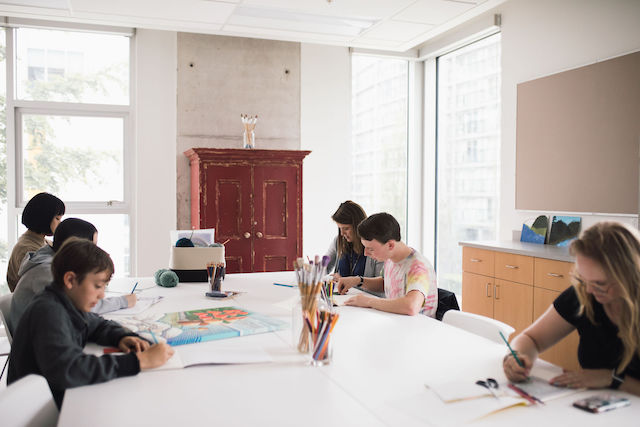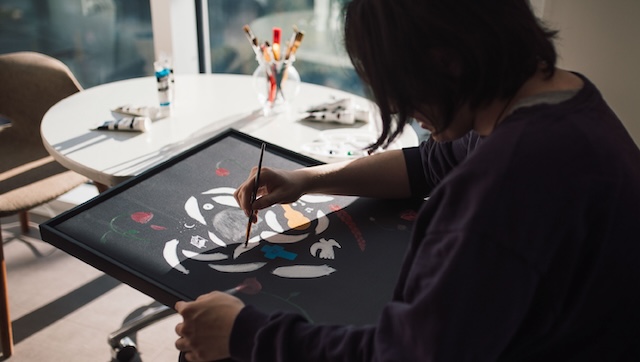Art Therapy for Youth at Covenant House Vancouver
The #CHVCatchUp is a monthly series featuring the latest updates and news from Covenant House Vancouver, written by the CHV team. Miss604 is proud to be the Official Blog Partner of CHV.
Art Therapy and Mental Health

The Benefits of Art Therapy for Youth at Covenant House Vancouver
Navigating mental health challenges can be overwhelming for youth who face housing insecurity and limited access to healthcare. Many have experienced trauma within systems that are meant to protect them. These experiences can make it difficult to engage with traditional mental health services.
Covenant House Vancouver (CHV) bridges these gaps by providing accessible, trauma-informed care. CHV offers a wide range of supports designed to address the mental and emotional well-being of youth, to remove barriers, and to help youth navigate their mental health journeys. One of the ways that CHV does this is by offering free art therapy for young people who access their services.
Caitlin Hall joined CHV in 2024 as a Registered Clinical Counsellor and Art Therapist. They have been overseeing CHV’s art therapy sessions for youth who access their services. Below is an interview with Caitlin that shares the work that they do, the importance of art therapy, and its success at CHV.
Why Did You Want to Join CHV?
I was drawn to working at CHV because of the dedicated art studio, which is an anomaly in the non-profit sector. Having a committed and protected location for creating and storing youth artwork is such a privilege and creates a trusting and safe environment for arts-based healing.
How Does Art Therapy Help?
Art therapy can be a bit of a sneaky way to give youth support. Some youth are unfamiliar, or uncomfortable, with the idea, or experience, of people helping them. It is normal for youth with complex trauma to have complex relationships with people who express or show care for them. Art therapy positions the art as an extension of the self, so when we bring the focus to the art, it can take the direct (and sometimes uncomfortable) attention off the youth.

This can be an indirect way of exposing youth to support and attention (via their art) and hopefully helps them build trust around receiving care from other people. Art therapy can be a way to express feelings without getting into specifics and can relieve the pressure of having to share verbally. It allows youth to develop a visual language to understand their thoughts, feelings, and experiences, which some youth have never shared out loud because it hasn’t been safe to do so. Art therapy offers an alternative to talk therapy, and offers a space to express and explore.
What Has Been the Response to Art Therapy?
We have a group of committed youth who join every session, and other youth who pop by occasionally. Many youth stay the entire two hours, and some drop by for a quick cup of tea and to have a chat. Most of the regularly attending youth have personal art projects. We have youth who come to paint, draw, sew, sculpt, collage, or try it all out! I try not to give too much creative direction unless youth ask for it; I like to give them space and agency to explore what they are personally drawn to. This way, I can do my best to meet them where they are at and to support their current creative interests.
How Does Art Support Youth?
In so many ways! Art gives youth a way to express and explore their feelings by creating something physical that they can look at and talk about. We sometimes need to get outside of ourselves, and words are not always available to us! We can explore and prompt alternative ways to check in with ourselves; instead of “How are you feeling?” — think about: What colour is it? What shape is it? How much space does it take up? Art can be a great way to explore mindfulness, and bring awareness to the senses. We may encourage attention to how different art materials feel, sound, or smell. Most youth have experienced trauma, which can rob them of choice or agency. Making art can be a low-stakes way to explore agency, by offering a range of art materials and creative opportunities. Ultimately, there is no right or wrong way to create art, which can be liberating and encouraging.
What Is Your Favourite Aspect of the Work that You Do?
I love to model creative problem solving, self-expression, and curiosity about the forever-varying process of artmaking. I sometimes make art alongside the youth, and I try to be openly verbal about the unknowns of my project. I publicly discuss the creative successes, failures, and questions that come up as I create. I remind myself and the youth that if something isn’t working, or if I get frustrated, I can always pause and come back to the project. It is incredible to see youth responding to their art (and themselves) with more patience, compassion, and curiosity. I love to foster a creative environment and support the community that’s built through artmaking, together. It is an honour to see creative and hardworking youth regularly come together and I love making art alongside them.
Find out more about what Covenant House Vancouver does to support youth and the importance of mental health in their latest issue of Belonging (their biannual newsletter).
Related:










